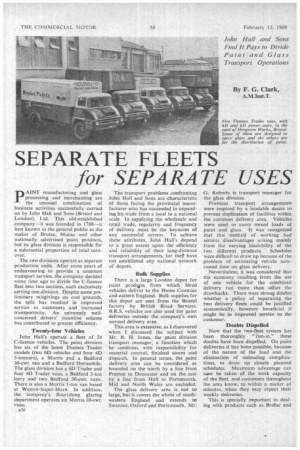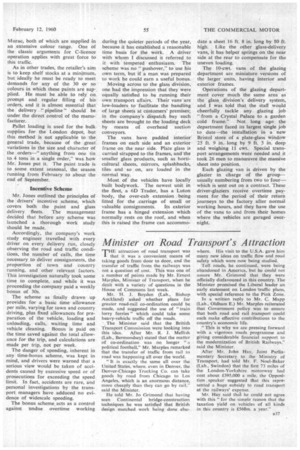SEPARATE FLEETS for SEPARATE USES
Page 70

Page 71

If you've noticed an error in this article please click here to report it so we can fix it.
pAINT manufacturing and glass processing and merehanting are the unusual combination of business activities successfully carried on by John Hall and Sons (Bristol and London), Ltd. This old-established company—it was founded in 1788—is best known to the general public as the maker of Brolac, Murac and other nationally advertised paint products, but its glass division is responsible for a substantial proportion of total turnover.
The two divisions operate as separate production units. After some years of endeavouring to provide a common transport service, the company decided some time ago to divide the C-licence fleet into two sections, each exclusively serving one division. Despite some preliminary misgivings on cost grounds, the split has resulted in improved service to customers and increased transportivity. An extremely wellconceived drivers' incentive scheme has contributed to greater efficiency.
Twenty-four Vehicles
John Hall's operate a fleet of 24 C-licence vehicles. The paint division has six of the latest Thames Trader models (two 6D vehicles and four 4D 5-toriners), a Morris and a Bedford 30-cwt. van and a Bedford Dorrnobile. The glass division has a 6D Trader and four 4D Trader vans, a Bedford 3-ton . lorry and two Bedford 30-cwt, vans. There is also a Morris 1-ton van based at Weston-Super-Mare. In addition, the company's flourishing glazing department operates six Morris 10-cwt. vans.
B36
The transport -problemsconfronting John Hall and Sons are characteristic Of those facing the provincial manufacturer who has succeeded in expanding his trade from a local to a national scale. In supplying the wholesale and retail trade, regularity and frequency of delivery must be the keynotes of any successful system. To achieve .thee attributes, John Hall's depend to a great extent upon the efficiency and reliability of their long-distance transport arrangements, for they have not established any national network of depots.
• Bulk Supplies
There is a large London depot for paint prochlits from which hired vehicles deliver to the Home Counties and eastern England. Bulk supplies for this depot are sent from the Bristol factory by British Road Services. B.R.S. vehicles are also used for paint deliveries outside the company's own normal delivery area.
This area is extensive, as I discovered when I discussed the subject with Mr. R. H. Jones, the paint division transport manager, a function which he combines with responsibility for material control, finished stores and dispatch. In general terms, the paint delivery area can be considered as bounded on the north by a line from Preston to Doncaster and on the east by a line from Hull to Portsmouth. Mid and North Wales are excluded.
The glass delivery area is not so large, but it covers the whole of southwestern England and extends to Swansea, Oxford and Portsmouth. Mr. G. Roberts is transport manager for the glass division.
Previous transport arrangements were inspired by a laudable desire to prevent duplication of facilities within the common delivery area. Vehicles were used to carry mixed loads of paint and glass. It was recognized that this method of working had serious disadvantages arising mainly from the varying loadability of the two different products. Schedules were difficult to draw up because of the problem of estimating vehicle turnround time on glass delivery.
Nevertheless, it was considered that the economy resulting from the use of one vehicle for the combined delivery run more than offset the drawbacks. There were strong doubts whether a policy of separating the two delivery fleets could be justified economically, however beneficial it might be in improved service to the customer.
• Doubts Dispelled Now that the two-fleet system has been thoroughly " fun-in," these doubts have been dispelled. On paint deliveries it has been possible, because of the nature of the load and the elimination of unloading complications, to draw up closely planned schedules. Maximum advantage can now be takenof the work capacity of the fleet, and customers throughout the area know, to within a matter of -minutes, when they may expect their weekly deliveries.
This is specially important in dealing with products such as Brolac and Murac, both of which are supplied in an extensive colour range. One of the classic argunrtents for C-licence operation applies with great force to this traffic.
As in other trades, the retailer's aim is to keep shelf stocks at a minimum, but ideally he must be ready to meet demands for any of the 30 or so colours in which these paints are supplied. He must be able to rely on prompt and regular filling of his orders, and it is almost essential that the delivery " pipeline " should be under the direct control of the manufacturer.
Pallet loading is used for the bulk supplies for the London depot, but this method is not applicable to the general trade, because of the great variations in the size and character of the orders—" anything from one tin to 4 tons in a single order," was how Mr. Jones put it. The paint trade is to some extent seasonal, the season running from February to about the end of September.
Incentive Scheme Mr. Jones outlined the principles of the drivers' incentive scheme, which covers both the paint and glass delivery fleets. The management decided that before any scheme was launched a thorough work study should he made.
Accordingly, the company's work study engineer travelled with every driver on every delivery run, closely observing the road and traffic conditions, the number of calls, the time necessary to deliver consignments, the proportion of town and country running, and other relevant factors. This investigation naturally took some time to complete, and while it was proceeding the company paid a weekly bonus of 30s.
The scheme as finally drawn up provides for a basic timeallowance per mile, varying for town and country driving, plus fixed allowances for preparation of the vehicle, loading and unloading, calls, waiting time and vehicle cleaning. Bonus is paid on the time saved against the total allowance for the trip, and calculations are made per trip, not per week.
The danger of speeding, inherent in any time-bonus scheme, was kept in mind, and drivers were warned that a serious view would be taken of accidents caused by excessive speed or of prosecutions for exceeding the speed limit. In fact, accidents are rare, and personal investigations by the transport managers have adduced no evidence of widescale speeding.
The bonus scheme acts as a control against undue overtime working during the quieter periods of-the year, because it has established a reasonable time basis for the work. A driver with whom I discussed it referred to it with tempered enthusiasm. The scheme was no "pushover," to use his own term, but if a man was prepared to work he could earn a useful bonus.
Moving across to the glass division, one had the impression that they were equally satisfied to be running their own transport affairs. Their vans-are low-loaders. to facilitate the handling of large sheets at customers' premises; in the company's dispatch bay such sheets are brought to the loading deck by means of overhead suction conveyors.
The vans have padded interior frames on each side and an exterior frame on the near side. Plate glass is carried strapped to the frames, and the smaller glass products, such as horticultural sheets, mirrors, splashbacks, tiles and so on, are loaded in the normal way.
Most of the vehicles have locally built bodywork. The newest unit in the fleet, a 6D Trader, has a Luton body, the over-cab extension being fitted for the carriage of small or valuable consignments. Its exterior frame has a hinged extension which normally rests on the roof, and when this is raised the frame can accommo date a sheet 16 ft. 8 in. long by 10 ft. high. Like the other glass-delivery vans, it has helper springs on the near side at the rear to compensate for the uneven loading.
The 10-cwt. vans of the glazing department are miniature versions of the larger units, having interior and exterior frames.
Operations of the glazing department cover much the same area as the glass division's delivery system, and I was told that the staff would cheerfully tackle any glazing job " from a Crystal Palace to a garden cold frame." Not, long ago the department faced its largest single job to date—the installation in a new Bristol store of a plate-glass window 25 ft. 9 in. long by 9 ft. 5 in. deep and weighing 11 cwt. Special transport arrangements were needed and it took 26 men to manoeuvre the massive sheet into position.
Each glazing van is driven by the glazier in charge of the group— usually numbering from two to four— which is sent out on a contract. These driver-glaziers receive overtime payment for the period of their return journeys to the factory after normal working hours, and they have the use of the vans to and from their homes where the vehicles are garaged overnight.




















































































































